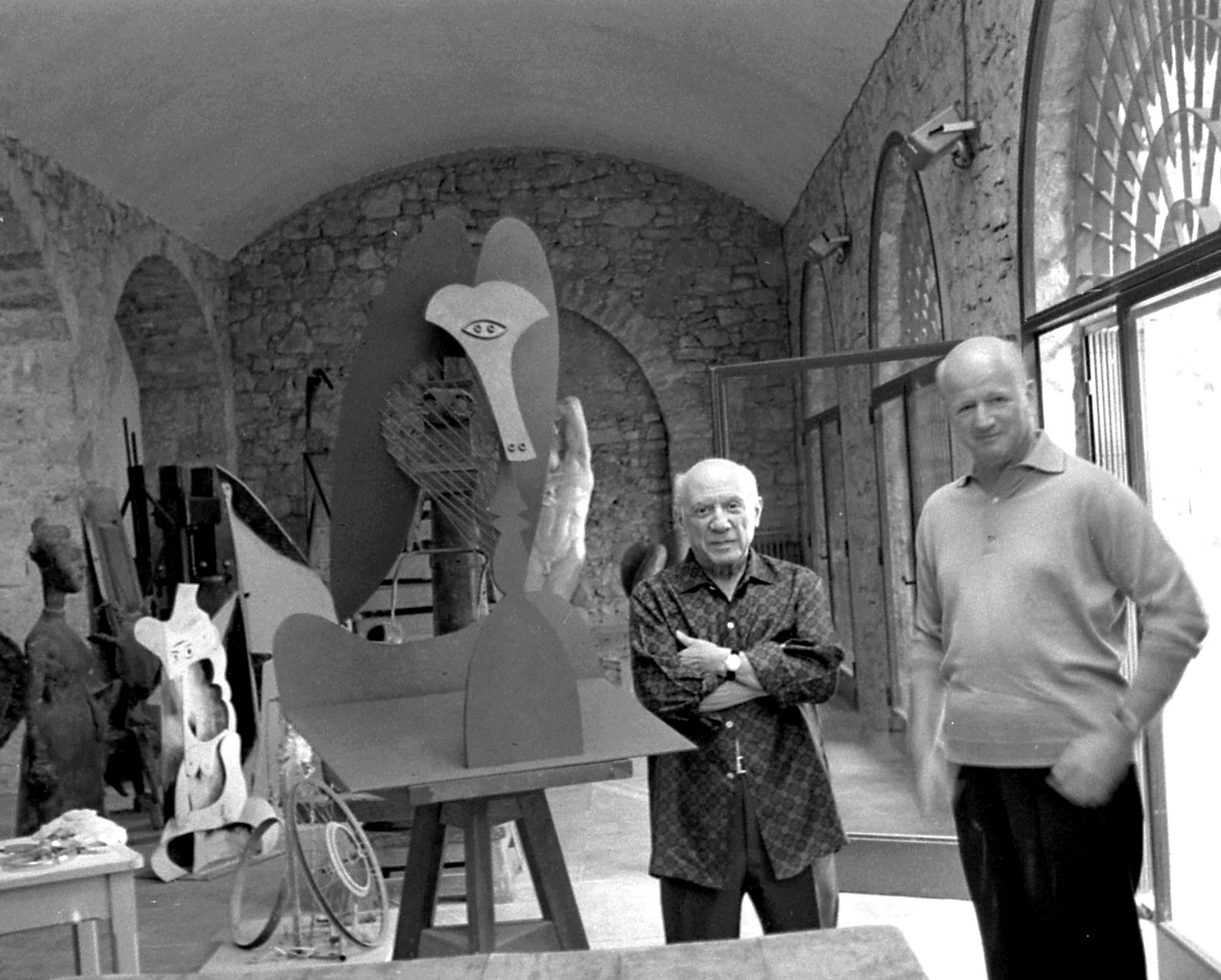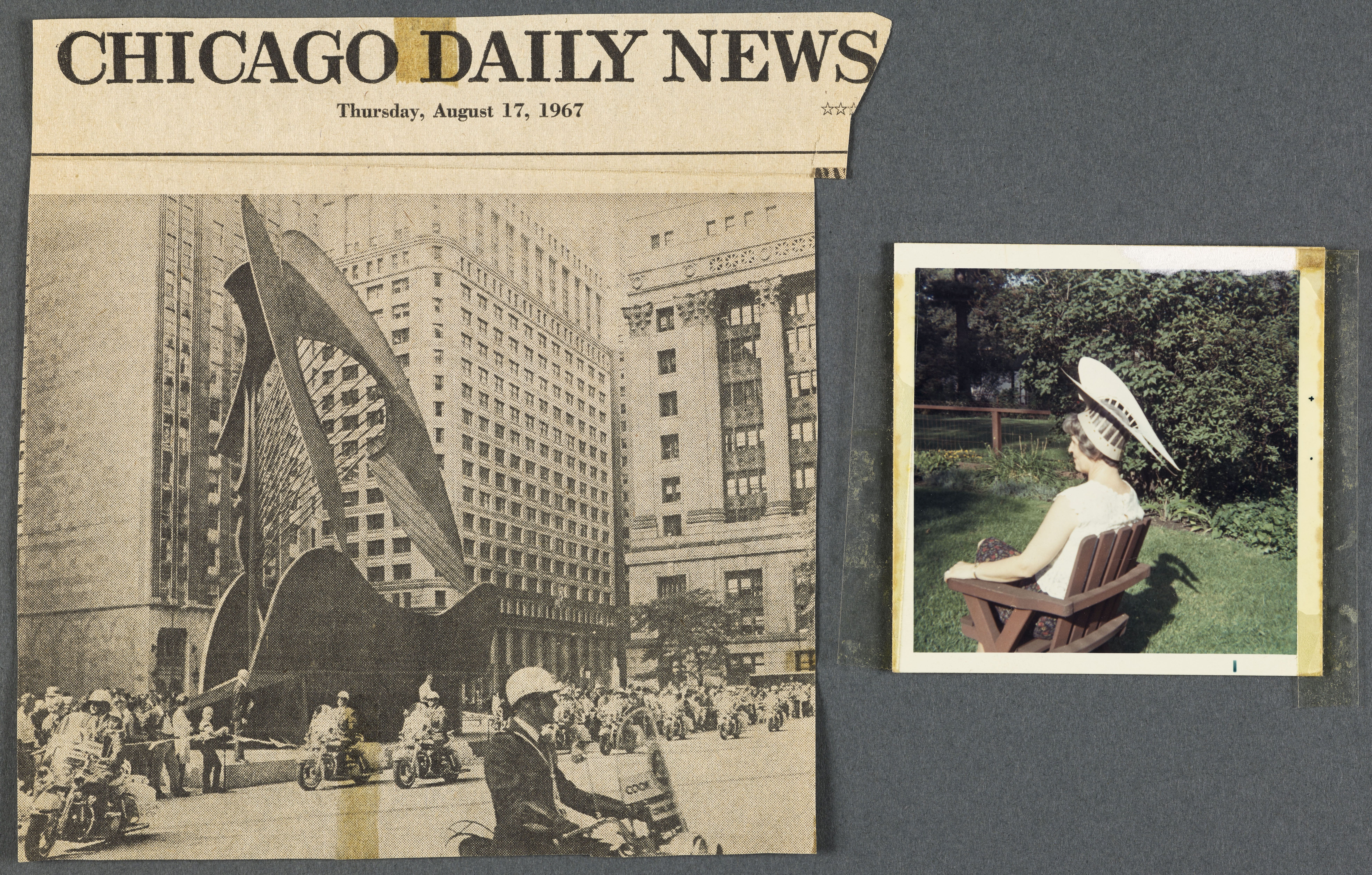
Unveiling of a large-scale metal sculpture by Pablo Picasso at Chicago’s Civic Center Plaza, 1967 © Photo courtesy of Skidmore, Owings & Merrill © Succession Pablo Picasso, VEGAP, Málaga, 2023
A maquette, a monument and a hat
The sculpture Picasso gave Chicago
Pablo Picasso gave the city of Chicago in the United States a sculpture more than 15 metres high and weighing 162 tons. Located in the city’s nerve centre, it soon became one of the most iconic landmarks.
The maquette
Architect Jacques Brownson of C. F. Murphy Associates designed the Richard J. Daley Center in 1965. This new, international-style building was planned with the idea of housing a sculpture in the plaza in front of the skyscraper.
But it was another architect, William Hartmann, who contacted Picasso in 1963 to present the project to him and give him this monumental commission. The idea aroused the interest of the artist, who, according to photographer Roberto Otero – a witness to this visit – exclaimed: ‘Now that I think it over it occurs to me that the only two cities which have made public monuments out of my sculptures are Marseilles and Chicago. Do you think it has something to do with gangsters?’
During the following months Hartmann crossed the Atlantic several times to meet the artist and progress with the planning of the monument – size of the maquette, tests for its location according to the sunlight, etc. During one of these visits, the architect presented him with a series of technical modifications made by his team of engineers to enable the structure to reach a height of more than 15 metres and withstand the force of the wind.
‘What madness! Do you realize! Have you seen these plans? As I understand it, some twenty architects have been working on this for more than a year. If I thought of all that while I was working I don’t know if I’d be able to do it. Many times I do think of it, and it scares me’, exclaimed Picasso in a conversation with Roberto Otero in Hartmann’s presence.
Picasso made two steel maquettes, one for himself and one for the architect, now in the Art Institute of Chicago. After the monument was unveiled, Hartmann returned to Mougins with a cheque for $100,000 for Picasso, but the artist refused it, expressing his wish that the work be a gift to the people of Chicago.
 Picasso and Hartmann next to the model of Head of a Woman. Notre-Dame-de-Vie (Mougins), August 1966. Fondo Roberto Otero. Museo Picasso Málaga © Fondo Roberto Otero. Museo Picasso Málaga, 2023 © Succession Pablo Picasso, VEGAP, Malaga, 2023
Picasso and Hartmann next to the model of Head of a Woman. Notre-Dame-de-Vie (Mougins), August 1966. Fondo Roberto Otero. Museo Picasso Málaga © Fondo Roberto Otero. Museo Picasso Málaga, 2023 © Succession Pablo Picasso, VEGAP, Malaga, 2023
The monument
Taking as a basis the maquette Picasso gave Hartmann, the American Bridge Company crafted the monumental work in the town of Gary (Indiana) using Cor-Ten steel. The huge pieces weighing 162 tons were transported to Chicago to be assembled there. The process of joining them was concealed from the public by awnings and scaffolding.
The Chicago Picasso was officially unveiled on August 15, 1967. Between the ceremonial events the Chicago Symphony Orchestra performed pieces by Leornard Bernstein and George Gershwin, and poet Gwendolyn Brooks publicly recited the poem Chicago’s Picasso.
The hat
When the curtain was pulled back to reveal the sculpture on August 15, the crowds voiced opinions of all kinds. Although it was unclear to the public whether it represented Picasso’s dog, an Egyptian god, a cow or a bird, the fact is that over time the Chicago Picasso marked a turning point in public sculpture in the United States in general and in Chicago in particular – characterised until then by the use of materials such as stone or marble and commemorative themes.
The work soon became one of the city’s landmarks. The creative responses were manifold, and it even inspired fashion garments such as the ‘Picasso Hat’ designed by Elisabeth Drees, who wrote a letter to Picasso enclosing several newspaper clippings and introducing him to her hat, which was ‘inspired by a walk around the sculpture, and the big picture in the Chicago Daily News’.
 Letter from Elizabeth Drees to Pablo Picasso, 1967. Impresión offset sobre papel. Musée national Picasso-Paris © RMN-Grand Palais (Musée national Picasso-Paris)/Mathieu Rabeau © Succession Pablo Picasso, VEGAP, Malaga, 2023
Letter from Elizabeth Drees to Pablo Picasso, 1967. Impresión offset sobre papel. Musée national Picasso-Paris © RMN-Grand Palais (Musée national Picasso-Paris)/Mathieu Rabeau © Succession Pablo Picasso, VEGAP, Malaga, 2023
Related Activities
Related Exhibitions

Picasso's Late Sculpture:Woman
The Collection in Context

Picasso Sculptor. Matter and Body
